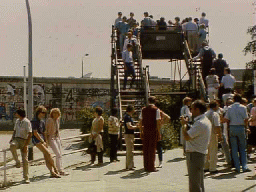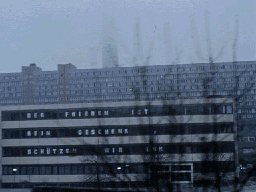

But what was life like in East Germany during the Wall? If we had looked over the Wall before November 9, 1989, what would we have seen? Here are some notes from my journal. The date is mid-June, 1989, a political light year ago: First, a psychological fact: It is well known that many East Berliners have a recurrent dream about flying over the Wall. The economy: you can't buy the things you need with the money you earn, simply because the things aren't there. Sometimes people stand in line for things just because there is something to stand in line for, often without knowing what it is. They can trade it later. If goods are there, they often have to resort to some other means of getting them, like having connections. If the Stasi (State Security Police) catches you, you are in trouble.
 | For decades, tourists in West Berlin looked over the Wall at a wooden stand near the Reichstag (July 1989) |
 |  |
| West Berliners take a look, November 89 | A French soldier peeks through Wall, November 1989 |
The GDR view of West Germany was that it was run by un-reconstituted faschists, an American puppet regime, out to savage the innocent GDR, which was fortunate to have the protection of the Soviet Army. Wherever possible, West Germany and West Berlin were ignored. Here is a map showing the Roads to Berlin, published in textbooks during GDR days: West Berlin is shown mainly as white space.
Salaries in the East average about 1200 Marks, about $250 a month. Rent for a nice flat is 32 marks. (Say, about six dollars a month.) Money is not the problem, but rather, the lack of goods and decent distribution of the existing goods. People buy houses and fix them up, so that nice interiors sometimes exist in houses that have shabby exteriors. There is a long wait for building materials, years, in fact.
People have children in order to get housing. There is a monetary reward system for having children. Most women work. They also do most of the standing on lines,which can take hours,leaving work several times a day if necessary. Overall, women do have advantages: jobs back automatically after four or five years at home bearing and taking care of children. There are lots of women judges and doctors, but basically, Dad is in charge of the family, period. He expects dinner on the table at supper time. There are free kindergartens and nursery schools,day-care centers. There is free medical care, but not of the highest standards.
Education: There are equal educational opportunities for all in East Germany, except that some are more equal that others. If you really want an education, to go to a university, say, or get a decent job, you have to join the FDJ, the Freie Deutsche Jugend.The FDJ is a combination boy-and-girl scout, social club, travel agency and political indoctrination association. The kids all wear blue uniforms, reminiscent of the Hitler Youth, except that their shirts are not brown. When and only when you have really proven yourself in the FDJ are you assured of a good future.

Proceed to 7. Bringing down the Wall from within or, switch to another Part:
1. Berlin at the End of WW II
2: The First Postwar Decade
3. The Raising of the Wall
4. West Berlin thrives
5. East Berlin, a tourist attraction
6. East Germany during the Wall
8. East meets West
9. East German Problems
10. The Road to Unification